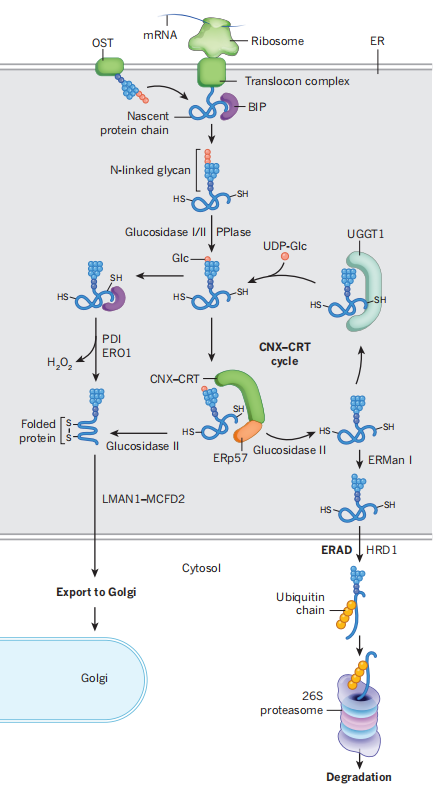In eukaryotic cells, the endoplasmic reticulum is an organelle involved in protein folding and entering the secretory pathway. The destruction of the cellular environment or the increase in protein synthesis often leads to misfolding of proteins in organelles, where misfolded or unfolded proteins accumulate—called endoplasmic reticulum stress, and the accumulated wrong proteins activate adaptive unfolded proteins React to restore homeostasis. If the misfolding of the protein cannot be resolved, the cell will die. The activation of endoplasmic reticulum stress and unfolded protein response helps determine the fate and function of cells. In addition, endoplasmic reticulum stress is one of the causes of many human diseases. Earlier, we introduced the pressure of endoplasmic reticulum and related signal transduction. Here we will talk about the relation of ER proteostasis and cell fate and function. In addition to the established role of endoplasmic reticulum stress and UPR in cell survival and protein secretion, existing studies have shown that they have a wider range of functions in cell physiology and metabolism regulation.
Cell Survival
From the previous introduction, we can know that UPR can promote cell survival, thereby reducing ER stress and restoring homeostasis. However, long-term UPR activation induces apoptosis via the PERK–eIF2α–ATF4–CHOP pathway. Studies have shown that the CHOP encoded by the gene DDIT3 can induce the expression of pro-apoptotic genes (such as DR5, TRB3, BIM and PUMA), and inhibit the expression of BCL2, thereby triggering apoptosis when the ER stress is triggered. In addition, ATF4-CHOP heterodimer also initiates the restoration of mRNA translation, resulting in increased protein synthesis, ATP depletion, oxidative stress and cell death. If the Ddit3 gene is deleted from the cell, ER stress causes less protein aggregation in the endoplasmic reticulum and reduces oxidative stress and apoptosis. If any other UPR gene is deleted, this will not happen instead. In addition, CHOP also activates ER oxidase 1α (ERO1α), an oxidoreductase that mediates the transfer of electrons to molecular oxygen during the formation of disulfide bonds to produce hydrogen peroxide. This reaction increases the ability to generate reactive oxygen species (ROS) from the ER and inositol-1,4,5-triphosphate receptor (IP3R) -mediated Ca2 + efflux. Ca2 + released from ER is absorbed by mitochondria through the ER membrane associated with mitochondria, thereby promoting mitochondrial ROS production through different mechanisms. The flux of Ca2 + between the endoplasmic reticulum and mitochondria may combine the protein folding ATP requirement with the mitochondrial production of ATP. Therefore, endoplasmic reticulum stress causes oxidative stress and impairs mitochondrial function, resulting in cell death in a CHOP-dependent manner.

Cell Growth And Differentiation
Cells need a large amount of protein in the process of proliferation and differentiation, which will cause an increase in protein synthesis, which is the main cause of endoplasmic reticulum stress and UPR activation. During ER stress, the monitoring mechanism delays the process of ER and cell division. It depends on the mitogen-activated protein kinase (MAPK) SLT2, but not on PERK, IRE1α and ATF6α (UPR sensors).
The discovery of the role of UPR in cell differentiation is demonstrated by the need for the IRE1α–XBP1 pathway in plasma cell differentiation. Since cell differentiation is related to the six-fold expansion of ER, the IRE1α–XBP1 pathway is required for the expansion of the secretory pathway in cells with large amounts of protein secretion. Interestingly, the increase of immunoglobulins load is not reason of the activation of the IRE1α–XBP1 pathway . Instead, it is caused by a differentiation-dependent signal from the B cell receptor that upregulates genes encoding components such as secretory pathways and plasma cell transcription factors, such as Mist1. Surprisingly, deleting PERK, eIF2α-P or ATF6α did not cause defects in plasma cell differentiation. In addition, XBP1 can induce a wide range of secretory pathway genes, as well as increased endoplasmic reticulum and lysosomal protein content, mitochondrial quality and function, ribosome number, and protein synthesis levels. Therefore, the IRE1α–XBP1 pathway significantly promotes the characteristic phenotypes of specialized secretory cells, such as gastric zymogen cells, β cells, and intestinal Paneth cells.
Cellular Metabolism
When the researchers discovered that PERK deletion and the mutation of the PERK phosphorylation site of eIF2α could cause defects in glucose metabolism, the link between ER stress signals and metabolism was confirmed. ER homeostasis and UPR activation are key to glucose and lipid metabolism. The steady state of blood glucose is strictly controlled by the levels of insulin and glucagon in the blood. ER homeostasis and UPR activation in insulin-secreting beta cells and hepatocytes that respond to insulin and glucagon play an important role in maintaining glucose homeostasis. And related studies have found that each UPR sub-pathway seems to maintain a liposomal homeostasis through different mechanisms.
Protein Secretion
ER is responsible for post-translational modification, folding and transportation of secreted proteins (such as cytokines and hormones). Endoplasmic reticulum stress inhibits the synthesis and secretion of secreted proteins through various mechanisms. A well-studied example is insulin. In beta cells, proinsulin interacts with many ER proteins to promote their folding and transport. For example, embryo knockout of XBP1 significantly impaired proinsulin processing. Because increased ER pressure and excessive activation of IRE1α induced RIDD, which degrades mRNAs20 encoding proinsulin processing enzymes. Therefore, during the transcription, translation, and secretion stages, endoplasmic reticulum stress and UPR activation affect insulin levels. Similarly, endoplasmic reticulum stress and the UPR pathway also affect other secreted proteins at the level of transcription or translation. Because these secreted proteins affect the function of distant organs, endoplasmic reticulum stress not only damages the survival and function of secreted cells, but also affects the entire organism.
